Functional Analysis of PsARRO−1 in Root Development of Paeonia suffruticosa
Abstract
1. Introduction
2. Materials and Methods
2.1. Plant Materials and Treatments
2.2. Anatomical Observation
2.3. Relative Expression Analysis
2.4. Subcellular Localization
2.5. Vector Construction
2.6. Transformation of Paeonia suffruticosa
2.7. Root Activity Determination
2.8. Statistical Analysis
3. Results
3.1. Identification and Analysis of PsARRO−1 Gene
3.2. Anatomical Observation
3.3. Real−Time Fluorescence Quantification of PsARRO−1 of Paeonia suffruticosa in Different Stages of Root Formation
3.4. Real−Time Fluorescence Quantification of PsARRO−1 of Paeonia suffruticosa In Vitro
3.5. Real−Time Fluorescence Quantification of PsARRO−1 of Paeonia suffruticosa in Soil
3.6. Subcellular Localization of PsARRO−1
3.7. Functional Verification of PsARRO−1
4. Discussion
5. Conclusions
Author Contributions
Funding
Institutional Review Board Statement
Informed Consent Statement
Data Availability Statement
Conflicts of Interest
References
- Li, Y.L.; Wu, D.Y.; Pan, S.L.; Xu, S.L. The study on micropropagation technology of tree peony plantlets in vitro. Chin. Sci. Bull. 1984, 8, 500–502. [Google Scholar]
- Beruto, M.; Lanteri, L.; Portogallo, C. Micropropagation of tree peony (Paeonia suffruticosa). Plant Cell Tiss Org. 2004, 79, 249–255. [Google Scholar] [CrossRef]
- Zhou, Z.Q. Taxonomy, geographic distribution and ecological habitats of tree peonies. Genet. Resour. Crop. Evol. 2006, 53, 11–22. [Google Scholar] [CrossRef]
- Guo, L.; Guo, S.; Xu, J.; He, L.; Carlson, J.E.; Hou, X. Phylogenetic analysis based on chloroplast genome uncover evolutionary relationship of all the nine species and six cultivars of tree peony. Ind. Crop. Prod. 2020, 153, 112567. [Google Scholar] [CrossRef]
- Meng, X.; Wang, Z.; He, S.; Shi, L.; Song, Y.; Lou, X.; He, D. Endogenous hormone levels and activities of IAA-modifying enzymes during adventitious rooting of tree peony cuttings and grafted scions. Hortic. Environ. Biotechnol. 2019, 60, 187–197. [Google Scholar] [CrossRef]
- Tian, D.K.; Tile, K.M.; Dane, F.; Woods, F.M.; Sibley, J.L. Comparison of shoot induction ability of different explants in herbaceous peony (Paeonia lactiflora Pall.). Sci. Hortic. 2010, 123, 385–389. [Google Scholar] [CrossRef]
- Gao, J.; Xue, J.; Xue, Y.; Liu, R.; Ren, X.; Wang, S.; Zhang, X. Transcriptome sequencing and identification of key callus browning-related genes from petiole callus of tree peony (Paeonia suffruticosa cv. Kao) cultured on media with three browning inhibitors. Plant Physiol. Biochem. 2020, 149, 36–49. [Google Scholar] [CrossRef]
- Wang, H.; Van, S.J. Establishment of in vitro cultures of tree peonies. South Afr. J. Bot. 2001, 67, 358–361. [Google Scholar] [CrossRef][Green Version]
- Bouza, L.; Jacques, M.; Sotta, B.; Miginiac, E. The reactivation of tree peony (Paeonia suffruticosa Andr.) in vitro plants by chilling is correlated with modifcations of abscisic acid, auxin and cytokinin levels. Plant Sci. 1994, 97, 153–160. [Google Scholar] [CrossRef]
- He, D.; Wang, Z.; He, S.L. Adventitious root generating process and hormone and enzyme changes in vitro Paeonia suffruticosa. Acta Hortic. Sin. 2011, 38, 770–776. [Google Scholar]
- Zhu, X.T.; Li, X.Q.; Ding, W.J.; Jin, S.H.; Wang, Y. Callus induction and plant regeneration from leaves of peony. Hortic. Environ. Biotechnol. 2018, 59, 575–582. [Google Scholar] [CrossRef]
- Jaime, A.; Teixeira, D.S.; Shen, M.M.; Yu, X.N. Tissue culture and micropropagation of tree peony (Paeonia suffruticosa Andr.). J. Crop Sci. Biotechnol. 2012, 15, 159–168. [Google Scholar] [CrossRef]
- Du, Y.M.; Cheng, F.Y.; Zhong, Y. Induction of direct somatic embryogenesis and shoot organogenesis and histological study in tree peony (Paeonia sect. Moutan). Plant Cell Tissue Organ 2020, 141, 557–570. [Google Scholar] [CrossRef]
- Ren, X.X.; Liu, Y.; Jeong, B.R. Callus induction and browning suppression in tree peony Paeonia ostii ‘Fengdan’. Hortic. Environ. Biotechnol. 2020, 61, 591–600. [Google Scholar] [CrossRef]
- Wen, S.S.; Chen, L.; Tian, R.N. Micropropagation of tree peony (Paeonia sect. Moutan): A review. Plant Cell Tissue Organ 2020, 141, 1–14. [Google Scholar] [CrossRef]
- Lydia, B.; Monique, J.; Emile, M. Requirements for in vitro rooting of Paeonia suffruticosa Andr. cv. ‘Mme de Vatry’. Sci. Hortic. 1994, 58, 223–233. [Google Scholar] [CrossRef]
- Xiao, Z.; Ji, N.; Zhang, X.; Zhang, Y.; Wang, Y.; Wu, T.; Xu, X.; Han, Z. The lose of juvenility elicits adventitious rooting recalcitrance in apple rootstocks. Plant Cell Tissue Organ 2014, 119, 51–63. [Google Scholar] [CrossRef]
- Han, J.G.; Song, Y.; Liu, Z.G.; Hu, Y.H. Culturable bacterial community analysis in the root domains of two varieties of tree peony (Paeonia ostii). Fems Microbiol. Lett. 2011, 1, 15–24. [Google Scholar] [CrossRef]
- Wang, H.Y.; He, S.L.; Tanaka, M.; Van, P.T.; Jaima, A.T. Effect of IBA Concentration, Carbon Source, Substrate, and Light Source on Root Induction Ability of Tree Peony (Paeonia suffruticosa Andr.) Plantlets in Vitro. Eur. J. Hortic. Sci. 2012, 77, 122–128. [Google Scholar] [CrossRef]
- Xue, D.; Huang, X.D. Changes in soil microbial community structure with planting years and cultivars of tree peony (Paeonia suffruticosa). World J. Microb. Biotechnol. 2014, 30, 389–397. [Google Scholar] [CrossRef]
- Shang, W.; Wang, Z.; He, S.; He, D.; Liu, Y.; Fu, Z. Research on the relationship between phenolic acids and rooting of tree peony (Paeonia suffruticosa) plantlets in vitro. Sci. Hortic. 2017, 224, 53–60. [Google Scholar] [CrossRef]
- Sun, M.; Zhou, W.Y.; Yang, Y.; Lv, M.W. Analysis of chemical components in the roots of eight intersubgeneric hybrids of Paeonia. Chem. Biodivers. 2021, 18, e2000848. [Google Scholar] [CrossRef]
- Zhao, D.Q.; Zhang, X.Y.; Fang, Z.W.; Wu, Y.Q.; Tao, J. Physiological and Transcriptomic Analysis of Tree Peony (Paeonia section Moutan DC.) in Response to Drought Stress. Forests 2019, 10, 135. [Google Scholar] [CrossRef]
- Khan, M.A.; Wang, Y.; Muhammad, B.; Uddin, S.; Saeed, A.; Khan, D.; Ali, M.; Saeed, S.; Kui, J.Z. Morpho-physiological and phytohormonal changes during the induction of adventitious root development stimulated by exogenous IBA application in Magnolia biondii Pamp. Braz. J. Biol. 2022, 84, e255664. [Google Scholar] [CrossRef]
- Xu, X.Z.; Che, Q.Q.; Cheng, C.X.; Yuan, Y.B.; Wang, Y.Z. Genome-wide identification of WOX gene family in apple and a functional analysis of MdWOX4b during adventitious root formation. J. Integr. Agric. 2022, 21, 1332–1345. [Google Scholar] [CrossRef]
- Smith, D.L.; Fedoroff, N.V. LRP1, a gene expressed in lateral and adventitious root primordia of Arabidopsis. Plant Cell 1995, 7, 735–745. [Google Scholar] [CrossRef][Green Version]
- Liu, H.; Wang, S.; Yu, X.; Yu, J.; He, X.; Zhang, S.; Shou, H.; Wu, P. ARL1. a LOB-domain protein required for adventitious root formation in rice. Plant J. 2005, 43, 47–56. [Google Scholar] [CrossRef]
- Lee, H.W.; Kim, N.Y.; Lee, D.J.; Kim, J. LBD18/ASL20 Regulates Lateral Root Formation in Combination with LBD16/ASL18 Downstream of ARF7 and ARF19 in Arabidopsis. Plant Physiol. 2009, 151, 1377–1389. [Google Scholar] [CrossRef]
- Smolka, A.; Welander, M.; Olsson, P.; Holefors, A.; Zhu, L.H. Involvement of the ARRO−1 gene in adventitious root formation in apple. Plant Sci. 2009, 177, 710–715. [Google Scholar] [CrossRef]
- Trupiano, D.; Yordanov, Y.; Regan, S.; Meilan, R.; Tschaplinski, T.; Scippa, G.S.; Busov, V. Identification, characterization of an AP2/ERF transcription factor that promotes adventitious, lateral root formation in Populus. Planta 2013, 238, 271–282. [Google Scholar] [CrossRef]
- Butler, E.D.; Gallagher, T.F. Isolation and characterization of a cDNA encoding a novel 2-oxoacid-dependent dioxygenase which is up-regulated during adventitious root formation in apple (Malus domestica ‘Jork 9’) stem discs. J. Exp. Bot. 1999, 50, 551–552. [Google Scholar]
- Butler, E.D. Characterization of auxin-induced ARRO−1 expression in the primary root of Malus domestica. J. Exp. Bot. 2000, 51, 1765–1766. [Google Scholar] [CrossRef]
- He, D.; Li, R.; Ji, S.Y.; Wu, J.; Wang, Z.; Liu, Y.P.; He, S.L. Cloning and Expression Analysis of Adventitious Rooting Related Gene PsARRO−1 of Tree Peony. Plant Physiol. J. 2014, 8, 1151–1158. [Google Scholar] [CrossRef]
- De, K.G.J.; Krieken, W.V.D.; Jong, J.C.D. Review the formation of adventitious roots: New concepts, new possibilities. Vitr. Cell. Dev. Biol.-Plant 1999, 35, 189–199. [Google Scholar] [CrossRef]
- Moriya, S.; Iwanami, H.; Haji, T.; Okada, K.; Yamada, M.; Yamamoto, T.; Abe, K. Identification and genetic characterization of a quantitative trait locus for adventitious rooting from apple hardwood cuttings. Tree Genet. Genomes 2015, 11, 59. [Google Scholar] [CrossRef]
- Yang, L.; Meng, H.; Ma, H.; Sun, T.; Li, Z.; Zhang, X.; Xu, J. Effect of Constriction on Content of Endogenous Hormones and Expression Rooting Related Genes During Shoot Layering of Apple Dwarfing Rootstock ‘9-3’. Acta Hortic. Sin. 2017, 44, 613–621. [Google Scholar] [CrossRef]
- Li, T.Y.; Wang, Y.; Zhang, X.Z.; Han, Z.H. Isolation and Characterization of ARRO−1 Genes from Apple Rootstocks in Response to Auxin Treatment. Plant Mol. Biol. Rep. 2012, 30, 1408–1414. [Google Scholar] [CrossRef]
- Honaas, L.; Kahn, E. A practical examination of RNA isolation methods for European pear (Pyrus communis). BMC Res. Notes 2017, 10, 237. [Google Scholar] [CrossRef]
- Li, P.; Dong, Q.; Ge, S.; He, X.; Verdier, J.; Li, D.; Zhao, J. Metabolic engineering of proanthocyanidin production by repressing the isoflavone pathways and redirecting anthocyanidin precursor flux in legume. Plant Biotechnol. J. 2016, 14, 1604–1618. [Google Scholar] [CrossRef]
- Tian, J.; Pei, H.; Zhang, S.; Chen, J.; Chen, W.; Yang, R.; Meng, Y.; You, J.; Gao, J.; Ma, N. TRV-GFP: A modified Tobacco rattle virus vector for efficient and visualizable analysis of gene function. J. Exp. Bot. 2014, 65, 311–322. [Google Scholar] [CrossRef]
- Ding, F.; Wang, R.; Chen, B. Effect of exogenous ammonium gluconate on growth, ion flux and antioxidant enzymes of maize (Zea Mays L.) seedlings under nacl stress. Plant Biol. 2019, 21, 643–651. [Google Scholar] [CrossRef] [PubMed]
- Song, Y.; Shang, W.; Wang, Z.; He, S.; Meng, X.; Shi, L.; Shen, Y.; He, D.; Lou, X.; Sun, Y. Transcriptome analysis and genes function verification of root development of Paeonia suffruticosa under sandy loam cultivation. Phyton-Int. J. Exp. Bot. 2022, 91, 2791–2812. [Google Scholar] [CrossRef]
- He, D. The Control on Rooting Culture of Paeonia Suffruticosa In Vitro. Master’s Thesis, Henan Agricultural University, ZhengZhou, China, 2009. [Google Scholar]
- Ji, S.Y. Temporal and Spatial Expression of Rooting Gene PsARRO−1 in Tree Peony. Master’s Thesis, Henan Agricultural University, ZhengZhou, China, 2013. [Google Scholar]
- Prescott, A.G.; John, P. DIOXYGENASES: Molecular Structure and Role in Plant Metabolism. Annu. Rev. Plant Biol. 1996, 47, 245–271. [Google Scholar] [CrossRef] [PubMed]
- Zhao, Y.L.; Chen, X.; Li, C.C. Dynamic of physiology and biochemistry during wild Rhododendron scabrifolium cutting propagation. Sci. Silvae Sin. 2013, 49, 45–51. [Google Scholar] [CrossRef]
- Zhu, C.H.; Gan, L.J.; Ng, D.; Xia, K. GA3 enhances root responsiveness to exogenous IAA by modulating auxin transport and signalling in Arabidopsis. Plant Cell Rep. 2015, 34, 483–494. [Google Scholar] [CrossRef]
- Han, Y.L.; Yoon, G.M. Regulation of Ethylene Biosynthesis by Phytohormones in Etiolated Rice e (Oryza sativa L.) Seedlings. Mol. Cell 2018, 41, 4. [Google Scholar] [CrossRef]
- Ubeda-Tomás, S.; Federici, F.; Casimiro, I.; Beemster, G.T.; Bhalerao, R.; Swarup, R.; Doerner, P.; Haseloff, J.; Bennett, M.J. Gibberellin signaling in the endodermis controls Arabidopsis root meristem size. Curr. Biol. 2009, 19, 1194–1199. [Google Scholar] [CrossRef]
- Li, J.; Zhao, Y.; Chu, H.; Wang, L.; Fu, Y.; Liu, P.; Upadhyaya, N.; Chen, C.; Mou, T.; Feng, Y.-Q.; et al. SHOEBOX Modulates Root Meristem Size in Rice through Dose-Dependent Effects of Gibberellins on Cell Elongation and Proliferation. PLoS Genet. 2015, 11, e1005464. [Google Scholar] [CrossRef]
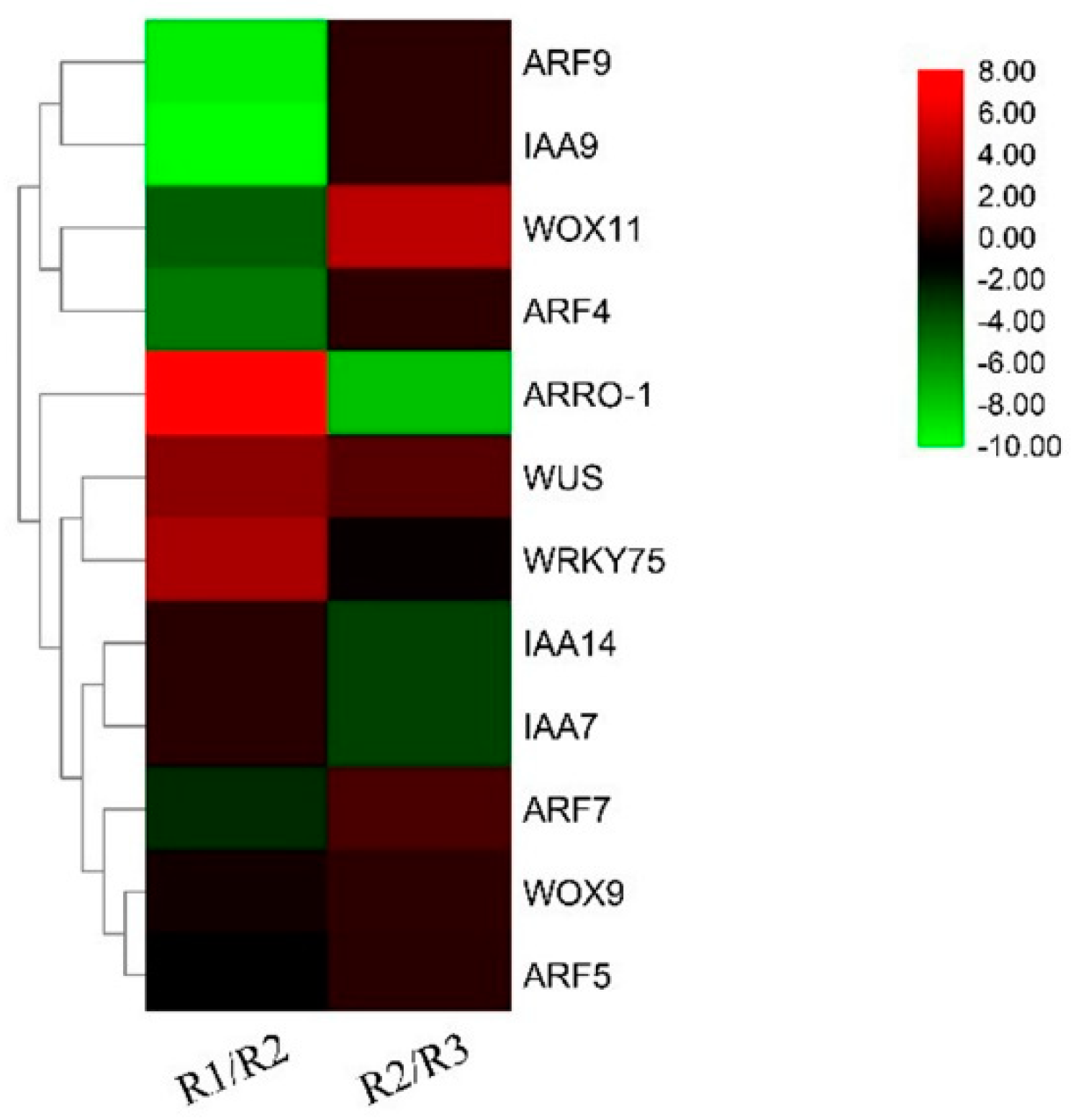
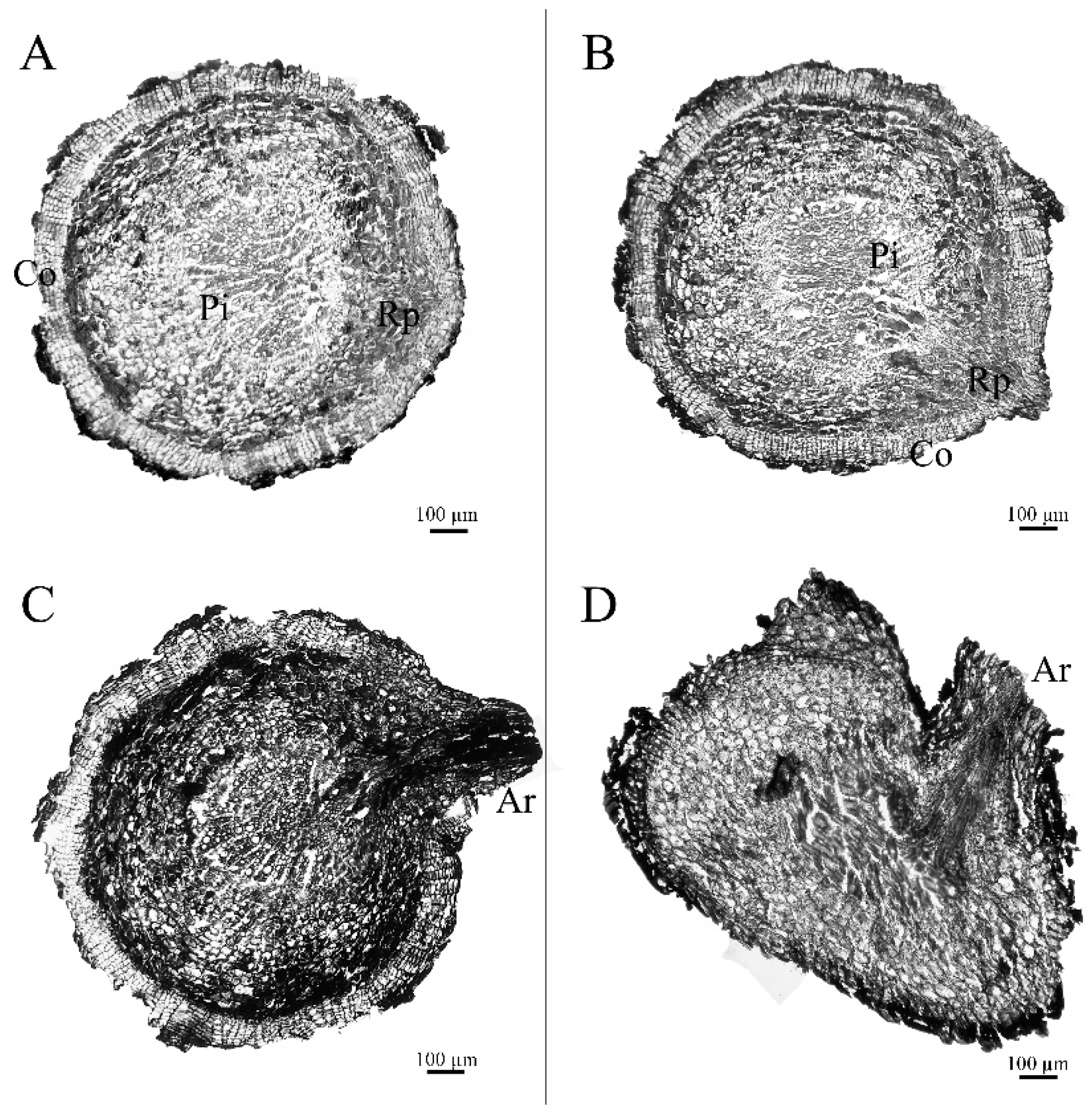
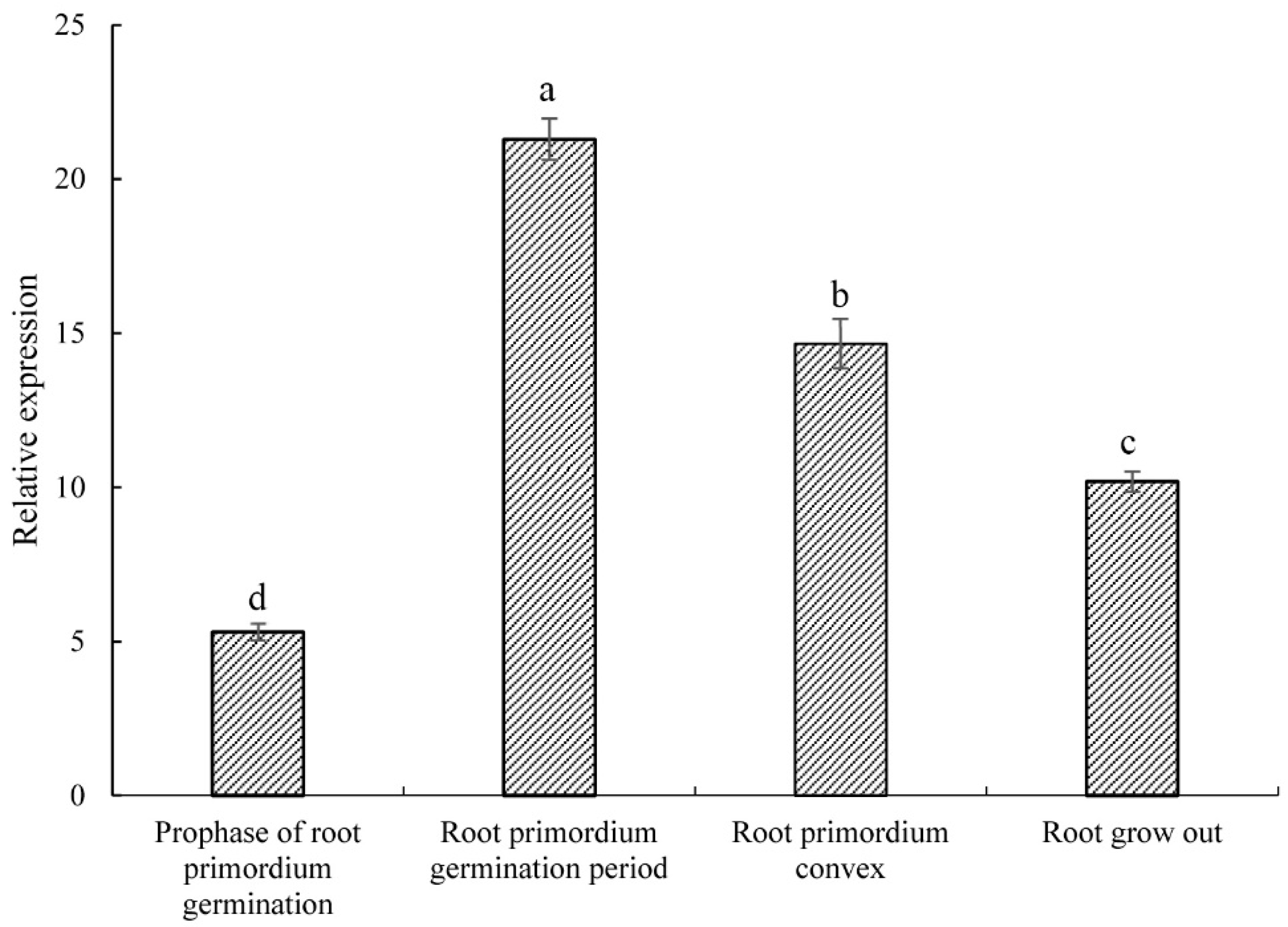
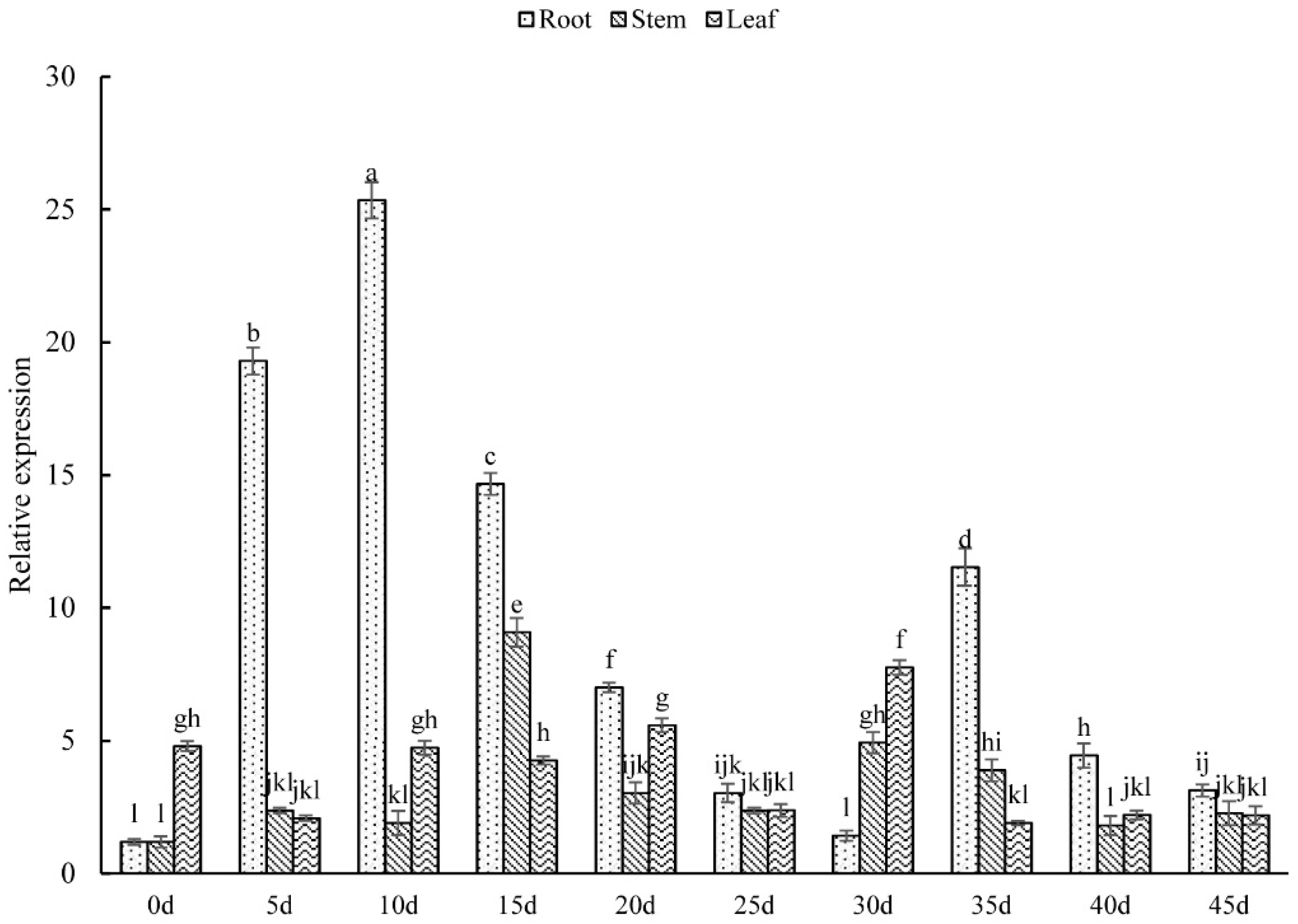
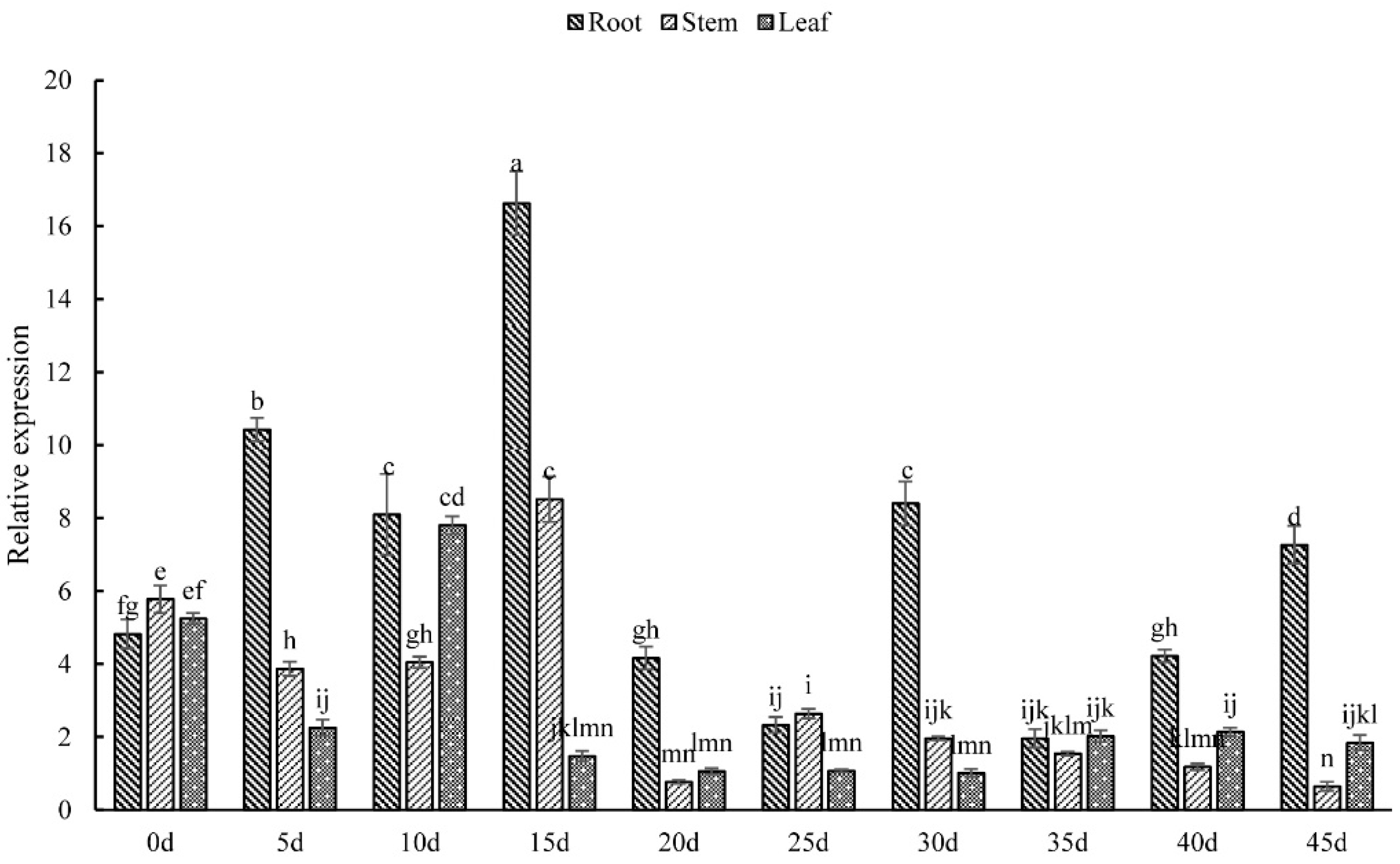


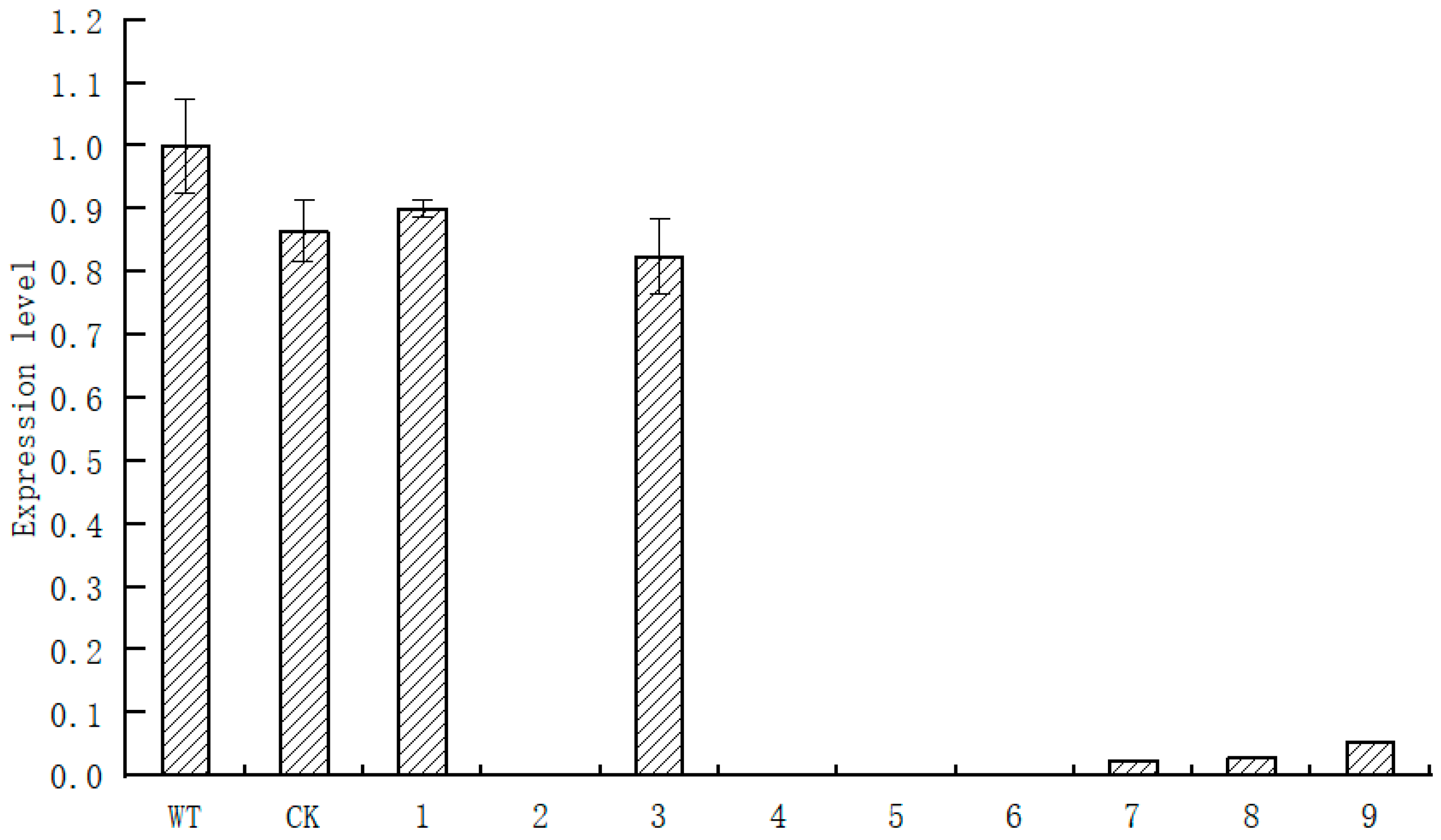

Publisher’s Note: MDPI stays neutral with regard to jurisdictional claims in published maps and institutional affiliations. |
© 2022 by the authors. Licensee MDPI, Basel, Switzerland. This article is an open access article distributed under the terms and conditions of the Creative Commons Attribution (CC BY) license (https://creativecommons.org/licenses/by/4.0/).
Share and Cite
Sun, Y.; Shang, W.; Yuan, J.; Wang, Z.; He, S.; Song, Y.; Shi, L.; Shen, Y.; Ma, J.; Xu, Y.; et al. Functional Analysis of PsARRO−1 in Root Development of Paeonia suffruticosa. Horticulturae 2022, 8, 903. https://doi.org/10.3390/horticulturae8100903
Sun Y, Shang W, Yuan J, Wang Z, He S, Song Y, Shi L, Shen Y, Ma J, Xu Y, et al. Functional Analysis of PsARRO−1 in Root Development of Paeonia suffruticosa. Horticulturae. 2022; 8(10):903. https://doi.org/10.3390/horticulturae8100903
Chicago/Turabian StyleSun, Yuke, Wenqian Shang, Junhui Yuan, Zheng Wang, Songlin He, Yinglong Song, Liyun Shi, Yuxiao Shen, Jie Ma, Yufeng Xu, and et al. 2022. "Functional Analysis of PsARRO−1 in Root Development of Paeonia suffruticosa" Horticulturae 8, no. 10: 903. https://doi.org/10.3390/horticulturae8100903
APA StyleSun, Y., Shang, W., Yuan, J., Wang, Z., He, S., Song, Y., Shi, L., Shen, Y., Ma, J., Xu, Y., & Wang, J. (2022). Functional Analysis of PsARRO−1 in Root Development of Paeonia suffruticosa. Horticulturae, 8(10), 903. https://doi.org/10.3390/horticulturae8100903





